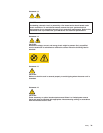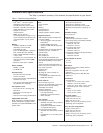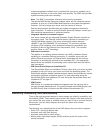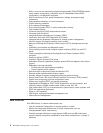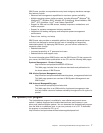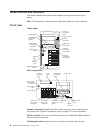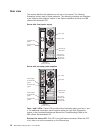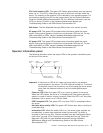
v Built-in, menu-driven electrically erasable programmable ROM (EEPROM) based
setup, system configuration, redundant array of independent disks (RAID)
configuration, and diagnostic programs
v Built-in monitoring for fan, power, temperature, voltage, and power-supply
redundancy
v Cable-presence detection on most connectors
v Chipkill memory protection
v Error codes and messages
v Error correcting code (ECC) L2 cache and system memory
v Fault-resistant startup
v Universal Serial Bus (USB) keyboard and mouse
v Hot-swap hard disk drives
v Integrated System Management Processor (ISMP)
v Information and Light Path Diagnostics LED panels
v Integrated service processor subsystem for remote system management
v Key lock support for physical security (tower model)
v Memory scrubbing and Predictive Failure Analysis (PFA) (background and real
time)
v Availability of microcode and diagnostic levels
v Parity checking on the small computer system interface (SCSI) bus and PCI
buses
v Power managed and Advanced Configuration and Power Interface (ACPI)
compliant
v Power-on self-test (POST)
v Predictive Failure Analysis (PFA) alerts
v Redundant Ethernet capabilities (requires optional Ethernet adapter) with failover
support
v Redundant hot-swap capability
– Cooling fans with speed-sensing capability
– Power supplies (some models)
v
Remind button to temporarily flash the Attention LED
v Remote system problem-determination support
v Standby voltage for system-management features and monitoring
v Startup (boot) from LAN using Preboot Execution Environment (PXE) protocol
v System auto-configuring from the configuration menu
v System error logging (POST and service processor)
v Upgradeable microcode for POST, BIOS, diagnostics, service processor, and
read-only memory (ROM) resident code, locally or over the LAN
v Vital product data (VPD) on microprocessors, system board, power supplies, and
SCSI (hot-swap-drive) backplane
v Wake on LAN capability
v IBM Director workgroup-hardware-management tool
v xSeries Server Management
IBM Director
With IBM Director, a network administrator can:
v View the hardware configuration of remote systems, in detail
v Monitor the usage and performance of critical components, such as
microprocessors, disks, and memory
v Centrally manage individual or large groups of IBM and non-IBM Intel-based
servers, desktop computers, workstations, and mobile computers on a variety of
platforms
6 IBM xSeries 235 Type 8671: User’s Guide




